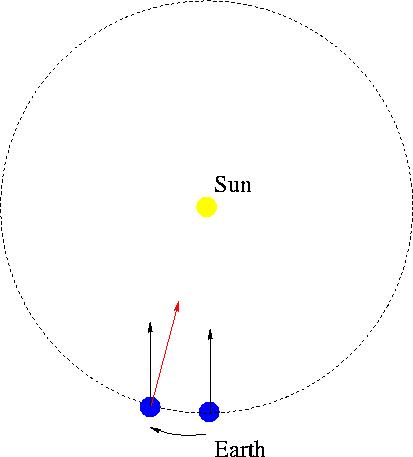In Class:
Question to Ponder
In 1966, the World Alpine Ski Championships were held at the ski
resort of Portillo, high in the Chilean Andes of South America. In
what month did this ski competition take place?
- a) December
- b) February
- c) March
- d) August
Dealing with the Earth's Revolution Around the Sun
- If the Sun were "off," we wouldn't notice our revolution around it.
- Directions to stars would not change perceptibly due to
displacement of the Earth, even across its 100 (actually 93)
million mile orbit.
- The same stars will appear in the same places after each full
rotation of the Earth on its axis.
Dealing with a "Lit" Sun
- Having the Sun "on" means that you can't see stars when you
can see the Sun (i.e., "daytime")
- Because we orbit the Sun, it (the Sun) appears in different
directions at different times of the year.
- "Nighttime" is when we're looking away from the Sun, so we'll see
a different set of stars at night at different times of the year.
Solar Time
- Solar time is "normal" time.
- Noon: Sun highest in the sky -- our part of the Earth is facing
toward the Sun
- Midnight: Twelve hours later -- our part of the Earth is facing
away from the Sun
- 24 hours between successive noons.
Sidereal Time
- Time required for one rotation of the Earth.
- Time interval required for a star to return to the same place in
the sky.
- 23 hours and 56 minutes -- NOT 24 hours.
Why is There a Difference?

- Consider a black arrow sticking directly out of the Earth
- A noon, this arrow points directly at the Sun.
- After one Sidereal day (23 hours 56 minutes), this arrow points
in the same direction again.
- However, the Earth has moved in its orbit around the Sun, so the
arrow no longer points at the Sun
- For the arrow to point at the Sun, the Earth must rotate an
additional four minutes (for a total of 24 hours of rotation)
- At that time, the arrow (now red) points at the Sun.
The "Tilt" of the Earth's Rotation Axis and the Seasons
- The Earth's rotation axis is tilted 23.5 degress relative to the
axis of the Earth's orbit about the Sun.
- This tilt is fixed in space; i.e., the Earth does not
wobble.
- As it orbits the Sun, the Earth's northern hemisphere is
alternately tilted toward then away from the Sun.
- Ditto for the southern hemisphere, except that the times are
shifted, i.e., when the Earth's northern hemisphere is tilted toward
the Sun, its southern hemisphere is tilted away from the Sun.
- When the northern hemisphere is tilted toward the Sun, the Sun
appears higher in our sky.
- Because the Sun is higher, a square foot of land receives more
solar radiation than it does in winter (when the Sun is lower in the sky).
- This makes the northern hemisphere warmer, and we have summer.
- The Sun is highest in the Sky in June, but because it takes a
little while for the Earth (and oceans) to warm up, the hottest days
of summer don't occur until July and August.
- The opposite effect occurs in winter, i.e., a square foot
receives less solar radiation because the Sun is lower in the sky.
- Because of the tilt, the Sun is "up" longer than 12 hours in the
summer, and shorter than 12 hours in the winter. This also contributes
to the temperature differences, but plays a much smaller role.
|
